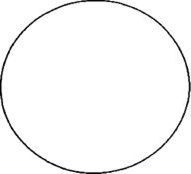3.4: Results
- Page ID
- 52275
Results
C. Methylene Blue-A Simple Stain
Sketch cellular shape (rods or cocci) and arrangement (single cells, pairs, clusters, chains) of the organisms observed with the oil-immersion lens (total magnification 1000X). Compare size and shape of the three microorganisms. You will need to be familiar with these for the next exercise and for identifying your unknowns.
The only way to become proficient with a microscope is to use it often and be observant while using it.
Saccharomyces cerevisiae- Eukaryotic Yeast

Bacillus megaterium

Micrococcus luteus

D. Test plate isolate
Sketch cellular shape and arrangement of the isolates from your "test plate" (total magnification, 1000X). In the next laboratory we will do a differential stain of this bacterial culture and show you how to use Bergey's Manual of Determinative Bacteriology.
"test plate isolate"

E. Demonstration slide

Sketch the cellular shape of Spirillum volutans.
Questions:
1.What are the structures seen on the end of these cells?
2. What is their function?

